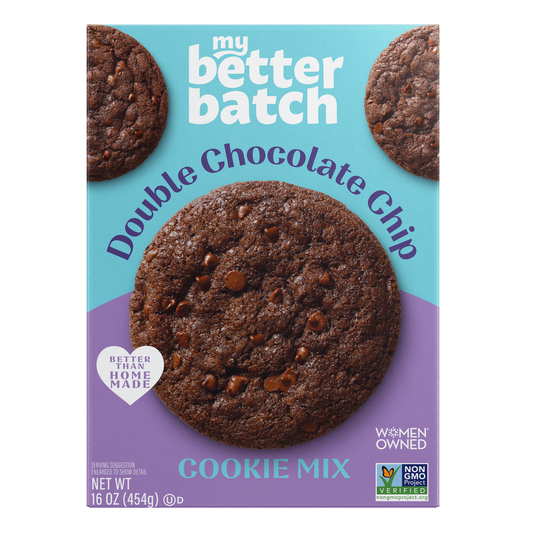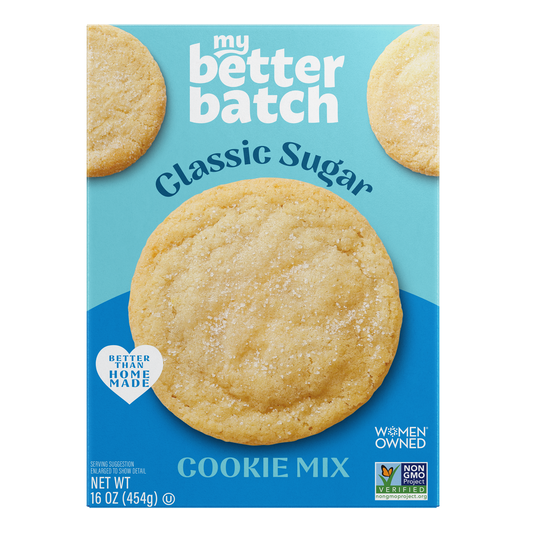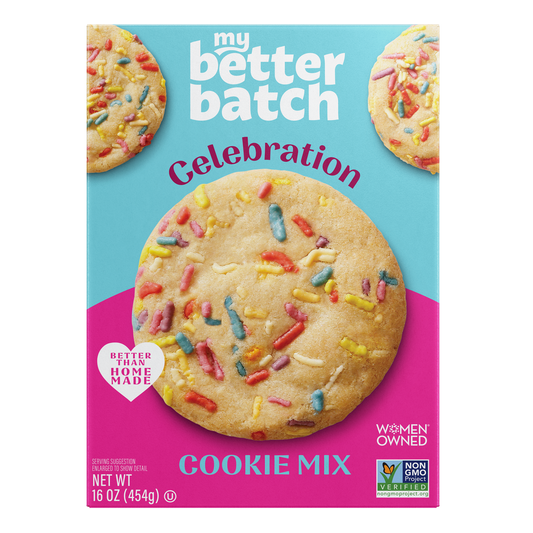Ever pull a tray of cookies from the oven, only to wonder why they spread too thin, stayed too puffy, or turned out rock-hard?
We've all been there.
Baking, at its heart, is a delicious dance between science and art, a culinary experiment where each ingredient plays a crucial role. But understanding why each ingredient matters can transform you from a recipe-follower to a cookie connoisseur.
In this article, we're diving deep into the fascinating science behind your favorite treats from My Better Batch, unraveling the mysteries of butter, eggs, flour, sugar, and more.
The Building Blocks: Understanding Each Ingredient's Role
Let's delve into the heart of the matter: the individual components that make up your cookie dough. Each ingredient plays a specific role, influencing everything from texture to flavor.
Butter: The Key to Flavor and Texture
Butter is one of the most important ingredients in cookies, contributing to both flavor and texture. It’s responsible for that rich, melt-in-your-mouth taste and plays a crucial role in determining whether your cookies turn out soft, chewy, or crispy.
How Butter Affects Texture
Butter is made up of fat and water. When mixed with sugar, it helps create air pockets in the dough, leading to a lighter texture. The way butter is used in a recipe can also change the final cookie:
-
Creamed Butter: When butter is beaten with sugar, it traps air, creating a light and fluffy texture. This leads to cookies that are slightly puffy and tender.
-
Melted Butter: Using melted butter results in cookies that spread more, giving them a chewier texture.
-
Cold Butter: In some recipes, like shortbread cookies, cold butter is used to create a more crumbly, delicate texture.
Butter’s Role in Flavor
Butter contains milk solids, which caramelize during baking, adding depth and a slightly nutty, rich flavor to cookies.
Fat Content and Gluten Development
Butter also plays a role in controlling gluten formation. Because fat coats the flour particles, it prevents too much gluten from developing, keeping cookies tender instead of tough.
In short, butter is the magic ingredient that brings flavor, tenderness, and structure to cookies. The way it’s incorporated into the dough can dramatically change the final result, making it a key player in the science of baking.
Egg: The Binder and Moisture Provider
Eggs are the glue that holds cookie dough together—literally! They play a crucial role in binding ingredients, adding moisture, and contributing to structure and texture. Without eggs, your cookies might crumble apart or lack the chewiness that makes them so satisfying.
How Eggs Affect Texture
Eggs contain both protein and fat, which work together to create structure and tenderness:
-
Protein (in the egg white): When baked, the proteins in eggs solidify, helping cookies hold their shape and preventing them from becoming too crumbly.
-
Fat (in the egg yolk): The yolk adds richness and softness, making cookies tender and giving them a slightly chewy texture.
The balance of egg white to yolk can impact a cookie’s consistency. More egg whites result in a firmer, slightly drier texture, while extra yolks make cookies richer and softer.
Eggs as a Leavening Agent
When eggs are beaten, they trap air, which helps cookies rise slightly. This is especially noticeable in recipes that call for whisking eggs with sugar to create a fluffier dough. While eggs don’t provide as much leavening power as baking soda, they do contribute to the overall lift and texture of the cookie.
The Role of Eggs in Moisture
Eggs contribute to the moisture content in cookie dough, preventing cookies from becoming too dry. They also help emulsify fat and water, ensuring all ingredients blend smoothly.
What Happens If You Leave Out the Egg?
Skipping eggs can lead to a crumbly, dry cookie that doesn’t hold together well. Some egg-free recipes use substitutes like applesauce, mashed banana, or flaxseed mixed with water to mimic eggs' binding and moisture-retaining properties.
Flour: The Foundation of Every Structure
Flour is the backbone of any cookie, providing the structure that holds everything together. Without it, your cookies would spread into puddles in the oven! But, not all flour is created equal - its protein content and how it interacts with other ingredients can drastically impact the final texture. In My Better Batch’s mixes, we use wheat flour based on its protein content - and add leavening agents separately.
How Flour Creates Structure
The key structural component in flour is gluten, a network of proteins that forms when flour is mixed with liquid. In cookies, gluten development needs to be balanced:
-
Too much gluten (from overmixing or using high-protein flour) results in tough, dense cookies.
-
Too little gluten (from under-mixing or using low-protein flour) leads to cookies that may be too delicate or crumbly.
This is why most cookie recipes call for all-purpose flour, which has a moderate protein content—perfect for a balance of chewiness and tenderness.
Flour’s Role in Absorbing Moisture
Flour absorbs liquid ingredients like butter and eggs, which helps create a cohesive dough. The amount of flour used affects the cookie’s consistency:
More flour = thicker, chewier cookies
Less flour = thinner, crispier cookies
This is why measuring flour correctly is crucial. Packing flour too tightly into a measuring cup can lead to dry, dense cookies. For best results, spoon the flour into the cup and level it off instead of scooping it directly from the bag.
Thankfully, when you use My Better Batch’s cookie mixes, you don’t need to worry about measuring the flour, we’ve done it for you!
Flour and Spread Control
Flour also helps control how much cookies spread in the oven. More flour means the dough holds its shape better, while less flour results in cookies that spread more. If your cookies turn out too flat, adding a little extra flour can help.
Sugar: Sweetness, Caramelization, and Spread Control
Sugar does more than just make cookies sweet - it affects their texture, color, and even how much they spread in the oven. The type of sugar used can drastically change the final result, making it a key ingredient in cookie chemistry.
How Sugar Affects Cookie Texture
Sugar plays a crucial role in determining whether cookies are crispy, chewy, or soft:
-
White Sugar (Granulated Sugar): Creates crispier cookies because it absorbs less moisture and promotes more spread.
-
Brown Sugar: Contains molasses, which adds moisture, creating a chewier and softer texture. It also adds a slight caramel flavor.
-
Powdered Sugar: Used in some recipes for extra tenderness, as it dissolves quickly and prevents too much gluten development.
Caramelization and Browning
Sugar is responsible for the beautiful golden-brown color of baked cookies. This happens through two chemical processes:
-
Caramelization: At high temperatures, sugar breaks down and creates deep, complex flavors.
-
The Maillard Reaction: When sugar reacts with proteins in flour and eggs, it produces a golden-brown crust and enhances the cookie’s flavor.
The more sugar in a recipe, the darker and more flavorful the cookies will become as they bake.
Sugar’s Role in Spread
Sugar affects how much cookies spread in the oven:
-
It melts during baking, which allows cookies to spread outward.
-
A higher sugar-to-flour ratio results in thinner, more spread-out cookies.
-
Brown sugar leads to less spread than white sugar due to its higher moisture content.
If your cookies are spreading too much, reducing the sugar slightly or chilling the dough before baking can help.
Natural Vanilla Flavor: The Aromatic Enhancer
Vanilla might not be the star ingredient in cookies, but it is crucial in enhancing the overall flavor profile. Without it, cookies can taste flat or one-dimensional. Even though vanilla doesn’t affect texture or structure, its aromatic compounds interact with other ingredients to create a richer, more well-rounded taste.
Why Even a Small Amount Makes a Big Difference
Most cookie recipes call for just a teaspoon of vanilla, but that small amount goes a long way. Vanilla is highly concentrated, and even in small doses, it rounds out the overall taste of cookies, preventing them from tasting too "eggy" or bland.
Natural vs. Artificial Vanilla
-
Natural vanilla flavor comes from real vanilla beans and has a more complex, deep, and slightly floral taste.
-
Artificial vanilla (vanillin) is a lab-created version of a single vanilla compound. While it provides a similar taste, it lacks the depth of natural vanilla.
Using high-quality vanilla can noticeably improve the flavor of cookies, making them taste richer and more indulgent.
Salt: The Unsung Flavor Booster
Salt might seem like a minor ingredient in cookies, but it plays a major role in enhancing flavor and balancing sweetness. Without salt, cookies can taste flat and overly sugary. While it doesn’t contribute to texture or structure, its presence makes all the other flavors shine.
The Science Behind Salt in Baking
Salt affects our taste buds by reducing bitterness and increasing our perception of sweetness. This is why even sweet recipes benefit from a little salt—it helps create a more well-rounded flavor profile.
How Much Salt is Too Much?
Most cookie recipes call for just a pinch or a small fraction of a teaspoon. Too much salt can overpower the sweetness and make cookies taste savory rather than dessert-like. However, some bakers like to sprinkle flaky sea salt on top of cookies for a contrast between sweet and salty flavors.
Cornstarch: The Secret to Soft and Tender Cookies
Cornstarch might not be in every cookie recipe, but when it is, it works wonders for texture. This fine, powdery ingredient is often added in small amounts to create softer, more delicate cookies. It also plays a role in thickening dough and preventing cookies from becoming too tough or dry.
How Cornstarch Affects Texture
Cornstarch is commonly used in baking to:
-
Soften cookies – It inhibits gluten formation, leading to a more tender, melt-in-your-mouth texture.
-
Prevent spreading – Cornstarch absorbs some of the moisture in the dough, helping cookies hold their shape better.
-
Create a light, delicate crumb – Because cornstarch is much finer than flour, it contributes to a soft, almost velvety texture in baked goods.
Cornstarch’s Role in Moisture Absorption
Cornstarch is excellent at absorbing liquid, which helps maintain the right balance of moisture in cookies. This is particularly useful in recipes where you want cookies to be soft but not greasy.
What Happens If You Skip Cornstarch?
Leaving out cornstarch won’t ruin a cookie recipe, but you might notice the difference in texture. Cookies could end up slightly denser, chewier, or more prone to spreading. If you love a soft, tender cookie, a little cornstarch can make all the difference!
Sodium Bicarbonate: The Leavening Agent That Makes Cookies Rise
Sodium bicarbonate, commonly known as baking soda, is a crucial ingredient in cookie recipes. It acts as a leavening agent, helping cookies rise and spread properly. Without it, cookies could turn out dense, flat, or overly tough.
How Baking Soda Works in Cookies
Baking soda is a base that reacts with acidic ingredients (such as brown sugar, yogurt, or honey) to produce carbon dioxide gas. This gas creates tiny air pockets in the dough, making cookies light and slightly puffy.
Effects of Baking Soda on Texture and Spread
-
Creates a chewy texture – Baking soda encourages cookies to spread more, leading to a thinner, chewier texture.
-
Affects browning – Because it raises the pH level of the dough, baking soda enhances the Maillard reaction, resulting in a more golden-brown color.
-
Balances acidity – Since baking soda is alkaline, it helps neutralize acidic ingredients, ensuring a more balanced flavor.
Cocoa Powder: The Key to Rich, Chocolatey Cookies
Cocoa powder is the magic ingredient behind our delicious Double Chocolate Chip cookie mix. It not only provides intense chocolate taste but also influences the cookie’s texture, moisture content, and even how it rises.
How Cocoa Powder Works in Cookies
Cocoa powder is a finely ground, unsweetened chocolate product made by removing most of the cocoa butter from cocoa beans. Since it lacks sugar and fat, it behaves differently than melted chocolate in a recipe. Cocoa powder:
-
Provides concentrated chocolate flavor – Without added fat or sugar, it delivers a bold, slightly bitter chocolate taste.
-
Absorbs moisture – Because it’s a dry ingredient, cocoa powder soaks up liquid, which can make cookies denser or fudgier.
-
Affects leavening – The type of cocoa powder used determines whether you should use baking soda or baking powder for proper rise.
My Better Batch cookies use Dutch-Processed Cocoa Powder, treated to reduce acidity, giving it a milder, darker, and smoother flavor.
The Perfect Cookie is All About Balance
Baking cookies might seem simple, but every ingredient plays a crucial role in creating the perfect batch.
While understanding the science behind baking is fascinating, sometimes you just want a foolproof and easy way to get perfect cookies every time, without the guesswork. That’s where My Better Batch cookie mixes come in!
Each mix is carefully crafted with the perfect balance of flour, sugar, baking soda, and other key ingredients, ensuring consistent results every time. No need to measure, experiment, or wonder if you got the ratios right—just add butter and an egg, mix, and bake.
Because My Better Batch uses clean, simple, non-GMO ingredients, you get homemade-quality cookies with zero hassle. Whether you love a soft and chewy bite or a perfectly crisp edge, these mixes take the science of baking and make it easy for everyone—busy parents, novice bakers, or anyone craving fresh, delicious cookies in minutes.
Why stress over getting every ingredient just right - grab your favorite cookie mix today!




